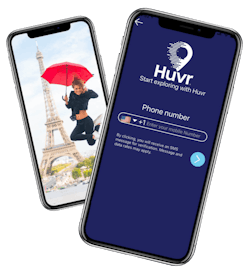From ‘leisure to vigilance’: Q&A with Huvr CEO Herman DeBoard III
Ensuring a venue’s perimeter remains secure is no longer solely a matter of hiring guards or placing obstacles. Teams must consider a marriage of multiple solutions to augment their physical security, with video analytics, AI and even cybersecurity playing a major role in securing events as large as the Olympics. As a new player in this field, Huvr, looks to make the most of its role by shifting its focus from leisure to vigilance.
Huvr was originally designed to capitalize on the burgeoning gig economy by enlisting local gig workers to provide customers with virtual tours of travel destinations and live events.
Following the 2023 acquisition of fiber optics company OpticSense, Huvr bought analytics startup Grip Places to further its own AI and machine-learning capabilities. With this new technology in its repertoire, the company now plans to expand the security applications of its flagship solution.
SecurityInfoWatch.com recently connected with Huvr CEO Herman DeBoard III to discuss his plans to transform in-person security with Huvr’s real-time threat analysis capabilities.
SIW: Huvr’s platform wasn’t originally designed for security purposes. What inspired you to pursue the security applications of this technology?
DeBoard: Initially, I launched Huvr as a platform to facilitate immersive virtual travel experiences. Of course, we still offer virtual tours and experiences today, but a recent acquisition caused us to expand our vision for Huvr.
OpticSense, which we acquired two years ago, was created by the retired lead scientist of Halliburton. Believe it or not, he was actually one of my next-door neighbors. He was like a mad scientist — always working on something new. He created a cool fiber optic ring called an interferometer, which enables someone to install fiber optics around a perimeter, transforming their entire facility into a highly sensitive microphone.
As a former government employee and a Gulf War veteran, I was very familiar with special forces setting up mobile military bases. Thanks to that background, I saw the benefits of combining Huvr’s real-time video streaming with this new fiberoptic ring interferometer. This technology allows anyone to establish their own smart perimeter detection system.
SIW: How does Huvr’s mobile security system work?
DeBoard: The core of Huvr’s security technology is the integration of AI with the fiber optic ring interferometer. Essentially, the highly sensitive fiber-optic loop detects minute disturbances. When it detects an anomaly — such as an unusual movement or sound — it immediately activates the next steps in the security protocol.
When an audio anomaly triggers the AI system, it immediately directs cameras toward the disturbance and analyzes a 60-second video clip. With the audio and video footage, the AI system compiles a detailed report that includes information such as the number of individuals involved, their appearances, and their movements. It immediately passes this information to security teams and the appropriate authorities.
The AI accurately classifies each anomaly according to its severity. Our AI algorithms are designed to continuously learn from each incident, enhancing their ability to accurately assess future risks. This means the system stores data from various incidents to become smarter over time. With our security systems deployed worldwide in banks, venues, and office buildings, each system contributes to a collective intelligence that makes future installations more effective.
SIW: What made OpticSense and Grip Places the ideal candidates to move forward with your vision for Huvr? How are their technologies utilized?
DeBoard: OpticSense's fiber optic technology can secure large areas without requiring alterations in a facility’s infrastructure. Its fiber optic cables can easily be buried or hidden, and the entire system can be operated discreetly by just one person. When installed and if the client requests it, it can detect critical keywords like "help," "bomb," or "gun" and can triangulate projectile directions to offer a threat’s precise location.
Grip Places enhances OpticSense’s capabilities with AI and machine learning algorithms. This technology transforms traditional security cameras into smart tools that continuously monitor and analyze security footage.
Together, OpticSense and Grip Places leverage the strengths of fiber optics, video analysis, and AI. The fusion of OpticSense’s physical disturbance detection with Grip Places’s intelligent video analysis creates a holistic security platform capable of proactive security measures.
SIW: In what environments would the solution be ideal to employ? Has it already officially deployed at any venues?
DeBoard: As a security system, OpticSense fits a wide range of use cases. The equipment is impervious to weather and electromagnetic disturbance, making it ideal for indoor and outdoor use. Being unaffected by the elements, it can secure every part of a facility, even the parking lot. With that in mind, it’s perfect for securing a perimeter around any infrastructure like power grids, cell towers, and bridges.
Because it’s a highly portable system that can be installed in one day, it suits the security needs of various events, ranging from small corporate gatherings to large-scale festivals. It can even offer security to massive events like the Olympics.
Our system is also discrete. The fiber optic cables can be concealed or buried, and the AI server is only the size of a shoe box. One person can operate the entire system from a small handheld device, allowing the system to offer security to a range of events without causing an interruption.
Huvr now protects a variety of facilities, including banks, schools, hospitals, stadiums and around major utility assets. It protects people at sporting events, concerts, and festivals, as well as valuable assets and critical infrastructure.



